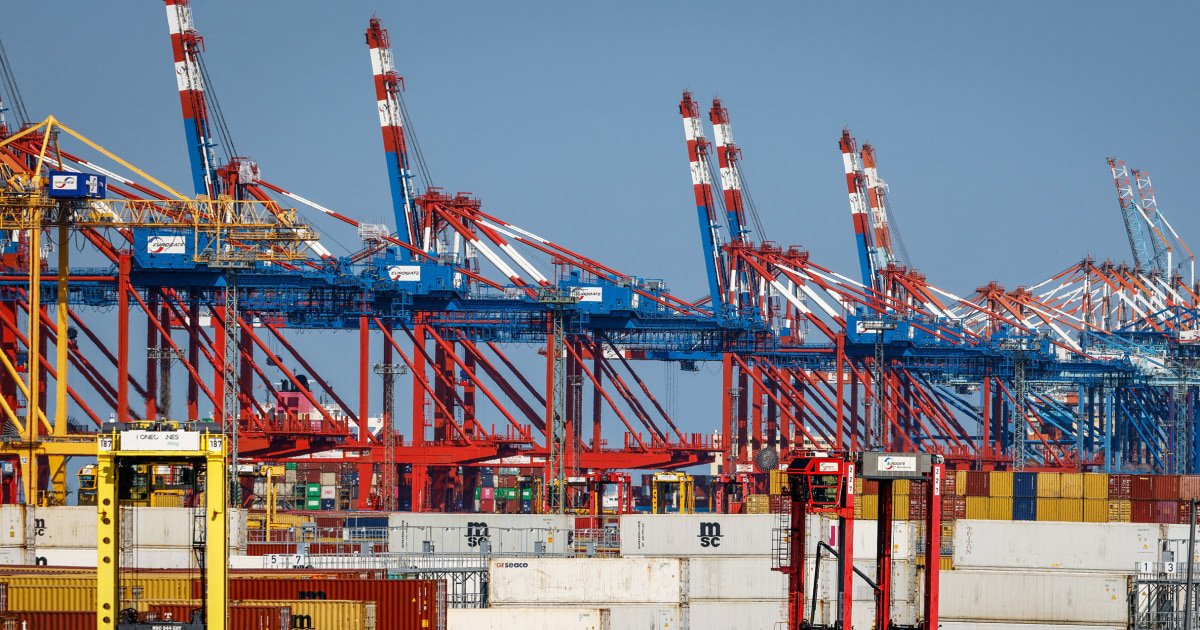President Donald Trump announced on Sunday a commercial agreement with the European Union that would establish 15%tariffs, ending what had been months of uncertainty around trade with the largest commercial partner of the United States.
The tariff rate is a 30% reduction that Trump threatened on July 12 and 20% that said he would impose on April 2.
When announcing the agreement, Trump said the EU will not impose a rate on imports from the United States. He added that this agreement was “satisfactory for both parties.”
Potentially more rates on the road
The president of the European Commission, Ursula von der Leyen, said on Sunday with Trump that the pact “will bring stability. It will bring predictability. That is very important for our businesses on both sides of the Atlantic.”
However, Trump said that 50% of tariffs on steel would remain unchanged and that even more rates could be on their way to pharmaceutical products, of which Ireland is one of the main sources. Trump recently threatened 200% of tariffs in pharmaceutical goods.
At the meeting with Von der Leyen, the secretary of Commerce, Howard Lutnick, said that semiconductor rates could also be announced in the coming weeks.
When reviewing parts of the agreement, Trump said that “the European Union will agree to buy in the energy of $ 750 billion in the United States.” He said the EU would also invest $ 600 billion in the United States. It was not clear how immediate that investment would take or during the period of time that would be implemented.
Trump added that EU nations will also buy “a large amount of military equipment”, although a definitive amount of purchase was not yet established. The European Commission has increased its military supplies, but until now it has focused on buying mainly from European companies.
Trump said this agreement would lead to the “opening of all European countries, which I think could say they were essentially closed.” However, the EU buys hundreds of billions of dollars in American goods every year. In 2024, that value was almost $ 400 billion.
The agreement seems to closely reflect the commercial agreement announced with Japan on Tuesday, by virtue of which Japanese imports will face an import tariff of 15%, which was also lower than Trump before threatened.
In an informative press session after the meeting with Trump, von der Leyen said that the 15% rate would not be stacked on any other rate that is already in force. She said that the United States and the EU have agreed to apply zero rates to a series of import categories: all aircraft and component parts, certain chemical products, generic pharmaceutical products, semiconductor equipment and some agricultural products.
“We will replace Russian gas and oil through significant purchases of us [liquified natural gas]Petroleum and nuclear fuels, ”he said. Von der Leyen said that the union will buy $ 250 billion in energy products per year during the course of a period of three years.
“Fifteen percent should not be underestimated, but it is the best we could get,” he added about the high task rate that will face the exports of the 27 European countries. “Fifteen percent is undoubtedly a challenge for some, but we must not forget that it maintains access to the US market.”
She described the meeting with Trump as “very difficult because we start very separated from each other.” In the end, he said it was “good and satisfactory.”
But last year, the United States average rate on imports from the European Union was only 1.2%, according to the head of Economy of Capital Economics.
The Ireland Prime Minister said in an X post that welcomed the treatment, but “it means that there will now be higher rates than there have been and this will have an impact on the EU and we, which makes it more expensive and more challenging.”
The German Prime Minister replied by saying: “A commercial conflict has been avoided that would have affected the German economy oriented with force. This is especially true for the automotive industry, where current tariffs will be reduced by half from 27.5% to 15%. This is precisely where the rapid reduction of tariffs is of great importance.”
The European Union has been in active negotiations with Lutnick and the commercial representative of the United States Jamieson Greer for weeks and had believed that he was extremely close to an agreement before Trump suddenly fired a letter about social truth by saying that he would increase tariffs to 30%. The main commercial negotiator of the EU made multiple trips through the Atlantic to meet with its American counterparts and was ready to talk to Lutnick again on Wednesday, according to an EU EU spokesman
“Imposing 30% tariffs on EU exports would interrupt the essential transatlantic supply chains, to the detriment of companies, consumers and patients on both sides of the Atlantic,” said Von LEIEN after Trump’s July letter.
Immediately after the letter, the EU said it would continue working towards an agreement of some kind before the new deadline of August 1. But the block continued to prepare simultaneously an extensive list of American products against which retaliation tariffs could apply if an agreement was not reached in the midst of fears that Trump could finish the conversations.
Some of these products included Boeing aircraft, American vehicles and imports of politically sensitive states, such as Kentucky Bourbon and Louisiana soybeans. At the time of the announcement, the EU had about $ 100 billion in reprisal rates ready to implement.
Agricultural and business groups had warned that 30% of tariffs on the European Union could dramatically affect the price and availability of wines, cheeses and pasta, and called the proposed tax “incomprehensible.”
Cars and other vehicles produced in the EU could still face greater prices. “The costs for our companies have already reached billions, and with each day that passes, the total continues to grow,” said the German trade group VDA to NBC News in a statement on July 14.
The 27 countries of the European Union are the largest commercial partner of the United States, their value of $ 605 billion in imports in the United States exceeds Mexico, Canada and even China. The most valuable import category in 2024 were drugs and pharmaceutical products mainly in Ireland, followed by cars, airplanes and other heavy machinery of nations such as France and Germany.
Trump has threatened separately with imposing a 200% rate on any imported drugs to the US, although it would not apply for at least 18 months. It was not clear if the agreement with the EU would avoid that.








